Fourth Industrial Revolution
4IR: Shaping and Defining New Roles for the Government
INDUSTRIE 4.0 focused on Manufacturing and Smart Factories

The Fourth Industrial Revolution is here to revolutionise the way we work, live and interact.
On April 2011, the world’s largest industrial fair held in Germany, Hannover Messe Industrie (HMI) Fair, saw the conceptualisation of a new terminology, Industrie 4.0 which was announced by Professor Wolfgang Wahlster, Director and CEO of the German Research Center for Artificial Intelligence.
Centered on manufacturing, it encompasses the usage of cyber-physical systems and Internet of Things, following automation in production to birth “smart factories”. It stands as one of 10 “future projects” identified by the German government as part of its High-Tech Strategy 2020 Action Plan.
Industrie 4.0, or Industry 4.0 (I4.0), a national strategic initiative pursued over a 10 to 15-year period, aims to propel digital manufacturing by increasing digitisation and the interconnection of products, value chains and business models. It aims to support research, the networking of industry partners and standardisation.
Although Wahlster publicly introduced the term in April 2011, at the HMI, it did not catch on until 2012. “Then the revolution started like a rocket.”
World Economic Forum 2016, Setting the Stage for Fourth Industrial Revolution (4IR)
The Davos summit in 2016 set the stage for the introduction of a relatively new term “Fourth Industrial Revolution” by Klaus Schwab, Founder and Executive Chairman of the World Economic Forum. In contrast to Industrie 4.0 coined by the Germans which focused on advancing the nation’s manufacturing sector, the Fourth Industrial Revolution (4IR) describes the dawn of a new era (see Fig 1) resulting from new technologies, the fusion of the physical, digital and biological spheres (see Fig 2) envisaged to impact and disrupt industries, education, jobs, government, society and economies.
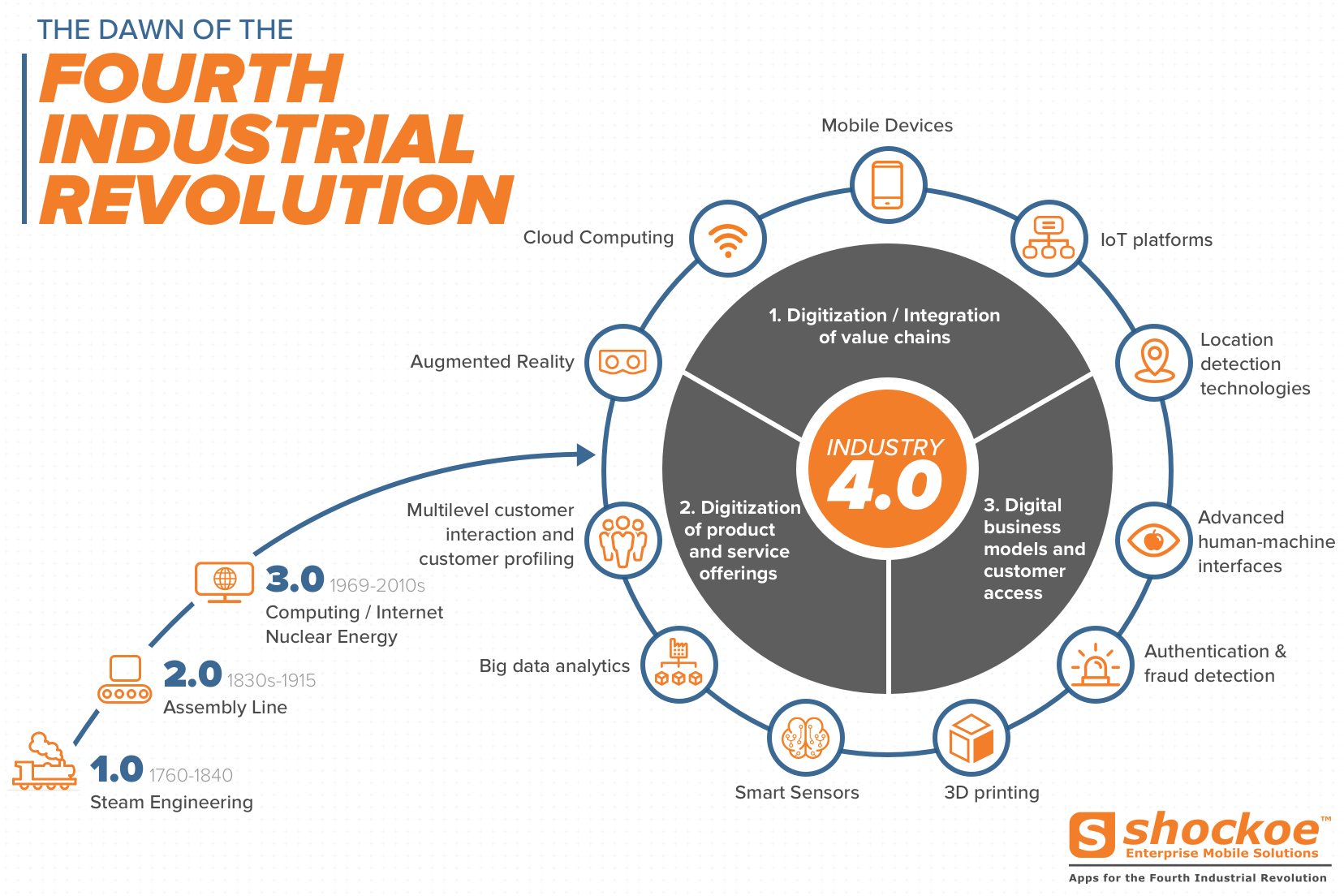
Source: shockoe

Source: shockoe
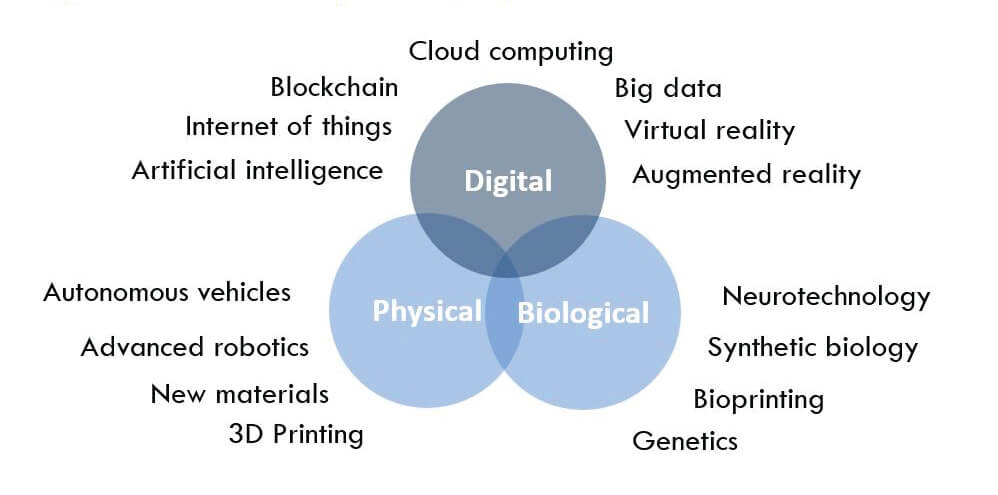
Source: John Grill Centre for Project Leadership and Silicon Valley Innovation Centre
Like the industrial revolutions before it, 4IR (see Fig 2) offers great opportunities and excitement as well as grave concerns and challenges.
The 4IR is of a scale, speed and complexity that is unprecedented. As we are still at the threshold of the 4IR, the norms, standards, infrastructure, regulations, and business models that will define the future are still emerging. Such critical decisions about the future of our economies, political systems, and societies must be deliberated and shared by a wide range of responsible stakeholders, including governments, industries, and interest groups.
4IR - A New Deal for Governments
A. Governance and Policy Making
The 4IR is of a scale, speed and complexity that is unprecedented. As we are still at the threshold of the 4IR, the norms, standards, infrastructure, regulations, and business models that will define the future are still emerging. Such critical decisions about the future of our economies, political systems, and societies must be deliberated and shared by a wide range of responsible stakeholders, including governments, industries, and interest groups.
The sheer speed of innovation and rapid adoption of new technologies unleashed by 4IR is disrupting traditional models of governance and changing how the Government works, policies and regulations are formulated. This ultimately poses a significant challenge for governments, in view that, as Former US Secretary of State Madeleine Albright has observed, as Government are tasked with understanding and responding to the range of 21st Century Challenges, armed with 20th Century Mindset and 19th Century Institutions.
Thus, it is imperative that today’s governments must evolve and transform to be agile to remain relevant and effective by addressing the challenges and harnessing the opportunities offered by 4IR (see Fig 3).
The WEF dovetails that the concept of agile government aims to shift the manner in which policies are being generated, deliberated, enacted and enforced in the 4IR; requiring a mindset change of policy makers, opening up policy work to truly innovative ideas and using new approaches; with each actors in the innovation system being involved in the process; not as providers of feedback but as co-designers of the outcome.
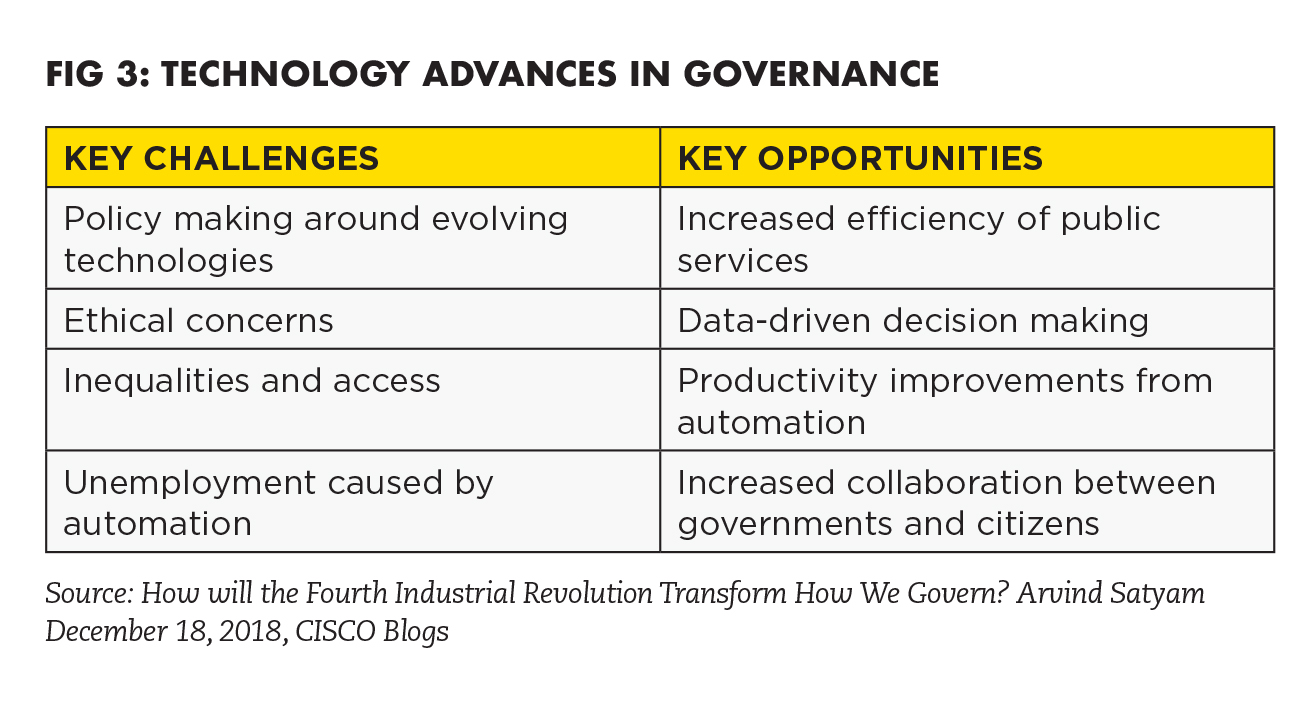
December 18, 2018, CISCO Blogs
World Economic Forum defines an eight-piece toolbox (see Fig 4) to guide agile governance:
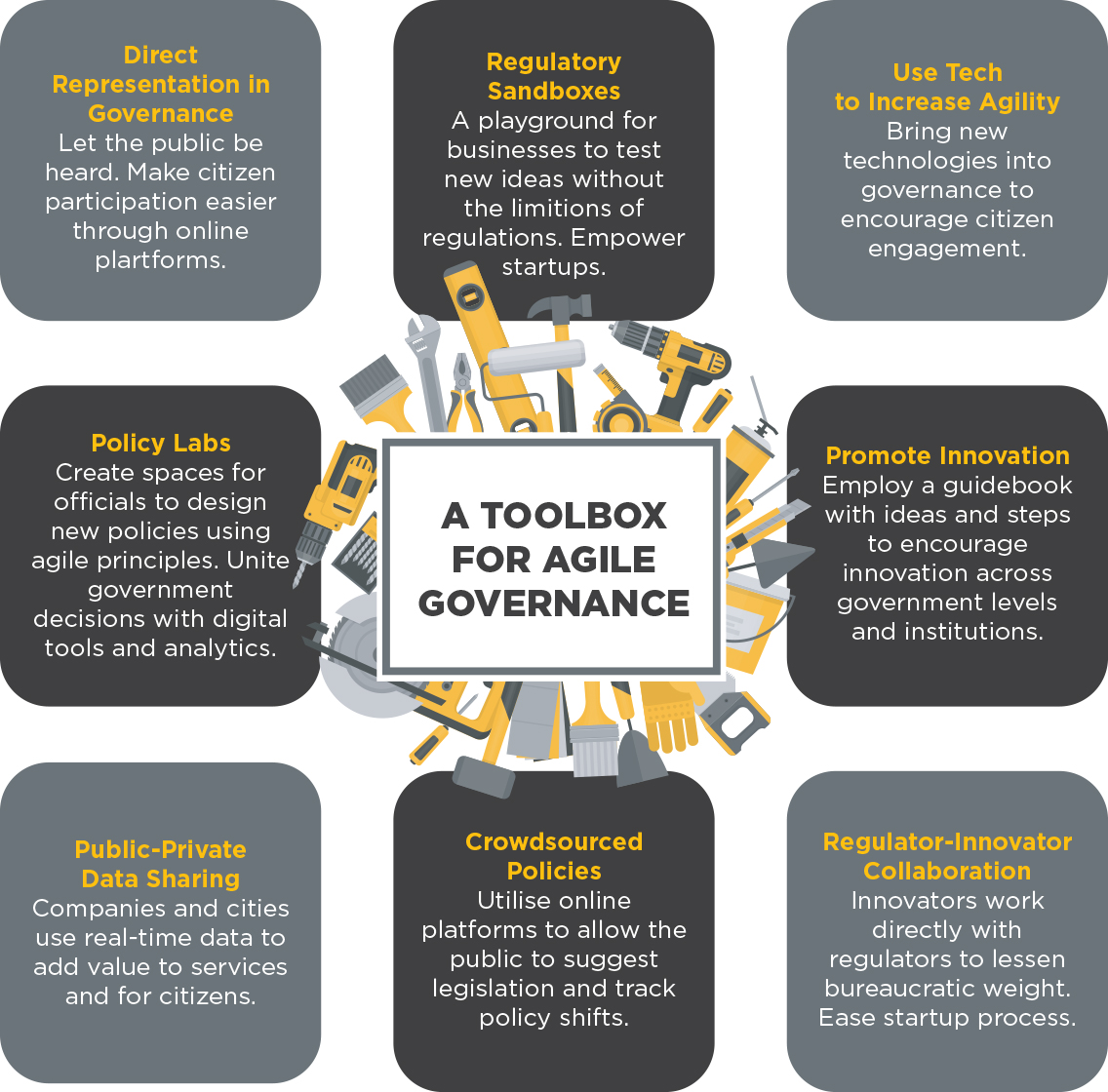
Source: World Economic Forum
The WEF, which is launching a Global Initiative on Agile Governance dedicated to reimagining policy making for the 4IR defines the concept of Agile Governance as “adaptive, human-centred, inclusive and sustainable policy making, which acknowledges that policy development is no longer limited to Governments but rather is an increasingly multi-stakeholder effort.”
Thus, to fully harness the potentials and benefits of 4IR, the Government must reimagine and redesign the way traditional Governance is managed and – amongst others – partner with businesses, citizens and civil society to share the governing of emerging technologies through establishing Innovation Labs, Policy Labs and Regulatory Sandboxes to offer space and platform for experimentation.
In the Malaysian context for multi-stakeholder engagement in policy formulation, the Ministry of International Trade and Industry (MITI) has launched a National Policy on Industry 4.0 referred as Industry4WRD with the thrust of ACT (Attract, Create and Transform) with stakeholders across several ministries and guided by five Technical Working Groups covering FIRST (F-Funding, I- Infrastructure, R-Regulation, S-Skills and Talents and T-Technology whilst the Minister of Multimedia and Communications, YB Gobind Singh Deo had recently launched a Malaysian Innovation Policy Committee (MIPC) established last September to serve as a platform for the private sector to propose digital tech initiatives that come with policy and regulatory challenges that hinder innovation and digital economic growth for the country.
MIPC comprises two committees – the Industry Coordination Committee that covers matters relating to industry collaboration pertaining to Digital Tech initiatives while the Intervention Committee focuses only on the policy and regulatory intervention.
- Recommendations for Malaysia – Incorporate additional factors for consideration by Technical Working Group
I would like to propose that whilst still maintaining the acronym FIRST, additional factors could be considered by the Technical Working Group such as I to include Innovation, IPR, S to include Standards, Safety and Society as these factors are fundamental for Malaysia to embrace 4IR effectively.
Recommendations for Malaysia – Set up Innovation or Policy Lab to test new innovative ways for policy making in the era of 4IR
A number of countries have established Innovation or Policy Labs to engage Government, private sector and citizens to discuss and offer new approaches or alternative solutions for governance and policy making; including MindLab in Denmark in 2002, EU Policy Lab. Malaysia could Initiate an Innovation or Policy Lab on public services developed by the Office of the Chief Secretary to the Government’s (KSN) or the Office of the Director-General of the Public Services (JPA) with members from both public and private sector a whilst MESTECC could establish a Policy Lab to develop Science, Technology and Innovation (STI) Policy in tandem with the requirements of the 4IR.
Recommendations for Malaysia – Restructure and rename Malaysia Innovation Policy Committee (MIPC)
Although this Committee is established short of two years, I would like to propose to YB Gobind for the MIPC to be restructured and renamed Malaysia Innovation Council or Committee (MIC) to not limit the Committee’s purview to just policy and regulation but to expand its mission and business to cover a broader scope including education, R&D, Standards, financing and Industry amongst others which are equally critical factors to promote and advance innovation.Then under this Committee, set up selected sub committees to review and recommend new or enhanced policies, regulations, standards, education, financing that are critical to support the growth of start-ups in the new emerging technologies including AI and Drone Technologies.
B. Regulations and Legislations to Support and Not Stifle Innovation
How Governance is Changing in the 4IR by Nima Elmi and Nicholas Davis of World Economic Forum, 18 January 2018 articulated that it is not just the adoption or regulation of technologies that are affecting governments.
As new technologies heralds new business models, new organisations, new products and services, Government must be agile to help regulators and legislators continuously adapt to a fast changing business, economic and social environment, without stifling innovation.
The importance of a business model will be more crucial in the era of 4IR because the basic character of the revolution is new combinations of technology and markets. Because without a proper business model, innovations in the Fourth Industrial Revolution cannot be fuelled and cannot grow further.
Inadvertently, new roles for policy makers are emerging, requiring a better balance between the need for safety and precaution with opportunities for the private sector to test new creations.
Some countries have created regulatory test-beds and sandboxes where regulations can be tested in different regulatory context. A case in point The Government of Sweden‘s policy for autonomous vehicle testing in Gothenburg and encouraging self-regulation through open source innovation associations like Partnership in AI, a technology industry consortium focused on establishing best practices for artificial intelligence systems.
Recommendations for Malaysia – Initiate an annual 4IR dialogue with the industry
I had the opportunity to attend a few Conferences and Workshops on AI and Drone Technology and had the privilege to join industry discussions and was surprised to hear on several occasions that industry felt that regulation of Drone technology could be further enhanced by the Government to support instead of stifling the growth of this tech-based business.

Fig 5: Author Ms Sheriffah had attended a number of Technologies of 4IR Conferences and Workshop, including My DroneX Workshop in Cyberjaya
Thus in addition to the Sub Committees of the MIC, it would be beneficial and impactful to initiate an annual or bi-annual 4IR Dialogue with Industry to gain direct feedback directly from industry for Government and policy makers and regulators to support innovation and fastrack 4IR for Malaysia.
2. Recommendations for Malaysia – Establish Sandboxes for Regulation of technologies of 4IR

Source: World Economic Forum
The WEF, which is launching a Global Initiative on Agile Governance dedicated to reimagining policy making for the 4IR defines the concept of Agile Governance as “adaptive, human-centred, inclusive and sustainable policy making, which acknowledges that policy development is no longer limited to Governments but rather is an increasingly multi-stakeholder effort.”
Thus, to fully harness the potentials and benefits of 4IR, the Government must reimagine and redesign the way traditional Governance is managed and – amongst others – partner with businesses, citizens and civil society to share the governing of emerging technologies through establishing Innovation Labs, Policy Labs and Regulatory Sandboxes to offer space and platform for experimentation.
In the Malaysian context for multi-stakeholder engagement in policy formulation, the Ministry of International Trade and Industry (MITI) has launched a National Policy on Industry 4.0 referred as Industry4WRD with the thrust of ACT (Attract, Create and Transform) with stakeholders across several ministries and guided by five Technical Working Groups covering FIRST (F-Funding, I- Infrastructure, R-Regulation, S-Skills and Talents and T-Technology whilst the Minister of Multimedia and Communications, YB Gobind Singh Deo had recently launched a Malaysian Innovation Policy Committee (MIPC) established last September to serve as a platform for the private sector to propose digital tech initiatives that come with policy and regulatory challenges that hinder innovation and digital economic growth for the country.
MIPC comprises two committees – the Industry Coordination Committee that covers matters relating to industry collaboration pertaining to Digital Tech initiatives while the Intervention Committee focuses only on the policy and regulatory intervention.
- Recommendations for Malaysia – Incorporate additional factors for consideration by Technical Working Group
I would like to propose that whilst still maintaining the acronym FIRST, additional factors could be considered by the Technical Working Group such as I to include Innovation, IPR, S to include Standards, Safety and Society as these factors are fundamental for Malaysia to embrace 4IR effectively.
Recommendations for Malaysia – Set up Innovation or Policy Lab to test new innovative ways for policy making in the era of 4IR
A number of countries have established Innovation or Policy Labs to engage Government, private sector and citizens to discuss and offer new approaches or alternative solutions for governance and policy making; including MindLab in Denmark in 2002, EU Policy Lab. Malaysia could Initiate an Innovation or Policy Lab on public services developed by the Office of the Chief Secretary to the Government’s (KSN) or the Office of the Director-General of the Public Services (JPA) with members from both public and private sector a whilst MESTECC could establish a Policy Lab to develop Science, Technology and Innovation (STI) Policy in tandem with the requirements of the 4IR.
Recommendations for Malaysia – Restructure and rename Malaysia Innovation Policy Committee (MIPC)
Although this Committee is established short of two years, I would like to propose to YB Gobind for the MIPC to be restructured and renamed Malaysia Innovation Council or Committee (MIC) to not limit the Committee’s purview to just policy and regulation but to expand its mission and business to cover a broader scope including education, R&D, Standards, financing and Industry amongst others which are equally critical factors to promote and advance innovation.Then under this Committee, set up selected sub committees to review and recommend new or enhanced policies, regulations, standards, education, financing that are critical to support the growth of start-ups in the new emerging technologies including AI and Drone Technologies.
B. Regulations and Legislations to Support and Not Stifle Innovation
B. Regulations and Legislations to Support and Not Stifle Innovation
How Governance is Changing in the 4IR by Nima Elmi and Nicholas Davis of World Economic Forum, 18 January 2018 articulated that it is not just the adoption or regulation of technologies that are affecting governments.
As new technologies heralds new business models, new organisations, new products and services, Government must be agile to help regulators and legislators continuously adapt to a fast changing business, economic and social environment, without stifling innovation.
The importance of a business model will be more crucial in the era of 4IR because the basic character of the revolution is new combinations of technology and markets. Because without a proper business model, innovations in the Fourth Industrial Revolution cannot be fuelled and cannot grow further.
Inadvertently, new roles for policy makers are emerging, requiring a better balance between the need for safety and precaution with opportunities for the private sector to test new creations.
Some countries have created regulatory test-beds and sandboxes where regulations can be tested in different regulatory context. A case in point The Government of Sweden‘s policy for autonomous vehicle testing in Gothenburg and encouraging self-regulation through open source innovation associations like Partnership in AI, a technology industry consortium focused on establishing best practices for artificial intelligence systems.
Recommendations for Malaysia – Initiate an annual 4IR dialogue with the industry
I had the opportunity to attend a few Conferences and Workshops on AI and Drone Technology and had the privilege to join industry discussions and was surprised to hear on several occasions that industry felt that regulation of Drone technology could be further enhanced by the Government to support instead of stifling the growth of this tech-based business.

Fig 5: Author Ms Sheriffah had attended a number of Technologies of 4IR Conferences and Workshop, including My DroneX Workshop in Cyberjaya
Thus in addition to the Sub Committees of the MIC, it would be beneficial and impactful to initiate an annual or bi-annual 4IR Dialogue with Industry to gain direct feedback directly from industry for Government and policy makers and regulators to support innovation and fastrack 4IR for Malaysia.
2. Recommendations for Malaysia – Establish Sandboxes for Regulation of technologies of 4IR
As new approaches in regulation of technologies of 4IR is pertinent to move in tandem with rapid technological innovation, MCMC could in addition to, or instead of, conducting discussions on regulating technologies of 4IR at the Malaysian Innovation Council, including drone technology, artificial intelligence, amongst other technologies, create sandboxes for regulation of these technologies (see Fig 5).
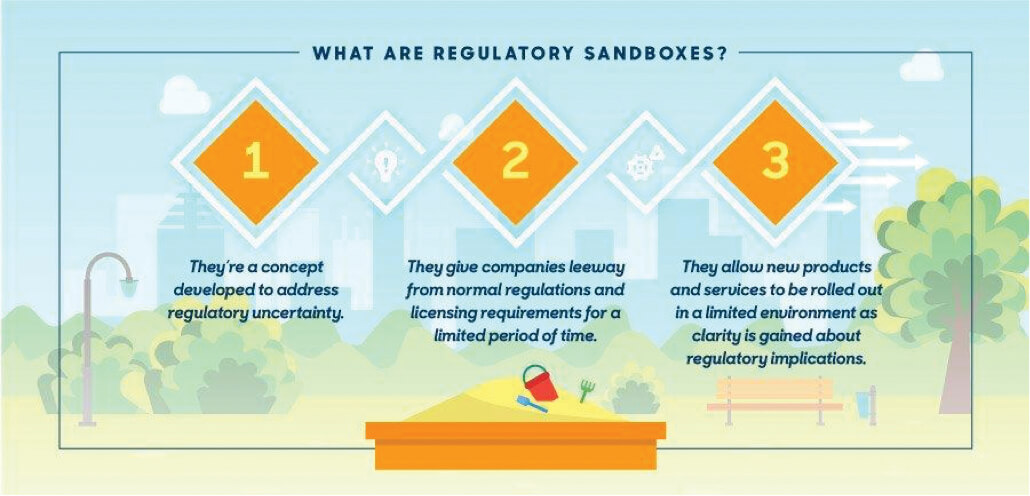
Source: Tsys.com
C) Education, Skills and Competency
Governments will need to strengthen leadership and develop human capital so that they are able to govern the technological transformation in a way that leaves no one behind.
Additionally, governments must cultivate a full understanding of the future, knowing what the opportunities and risks ahead are, as well as what their applications would be to the world, to individual countries, and to the specific workings of government. Governments also need to be smart when scanning the horizon; the advent of 4IR adds to the pressure on governments to become future-savvy.
1. Recommendations for Malaysia – The government needs to make preparations to be agile and future-savvy
As only a limited number of Government officials and private sector may have the opportunity to participate in the WEF’s Global Initiative on Agile Governance, these officials could be invited to share the discussions and deliberations with a larger number of civil servants at relevant briefings.
And the National Institute of Public Administration (INTAN), could introduce a course on the important aspect of Agile Governance for Politicians as well as Senior and Mid-level Civil Servants. Furthermore, Futurise and MIGHT at Cyberjaya could introduce 4IR for Government courses in partnership with WEF and other collaborators.
Financing and Funding
As emerging new technologies are paving the way for new industries, the funding and financing models will be very similar to tech ventures where different sources of financing are required at different stages of venture development, with early stage and start-ups requiring business angel and venture capital financing and crowdsourcing emerging as important new financing option.

Source: Tsys.com
C) Education, Skills and Competency
Governments will need to strengthen leadership and develop human capital so that they are able to govern the technological transformation in a way that leaves no one behind.
Additionally, governments must cultivate a full understanding of the future, knowing what the opportunities and risks ahead are, as well as what their applications would be to the world, to individual countries, and to the specific workings of government. Governments also need to be smart when scanning the horizon; the advent of 4IR adds to the pressure on governments to become future-savvy.
1. Recommendations for Malaysia – The government needs to make preparations to be agile and future-savvy
C) Education, Skills and Competency
Governments will need to strengthen leadership and develop human capital so that they are able to govern the technological transformation in a way that leaves no one behind.
Additionally, governments must cultivate a full understanding of the future, knowing what the opportunities and risks ahead are, as well as what their applications would be to the world, to individual countries, and to the specific workings of government. Governments also need to be smart when scanning the horizon; the advent of 4IR adds to the pressure on governments to become future-savvy.
1. Recommendations for Malaysia – The government needs to make preparations to be agile and future-savvy
As only a limited number of Government officials and private sector may have the opportunity to participate in the WEF’s Global Initiative on Agile Governance, these officials could be invited to share the discussions and deliberations with a larger number of civil servants at relevant briefings.
And the National Institute of Public Administration (INTAN), could introduce a course on the important aspect of Agile Governance for Politicians as well as Senior and Mid-level Civil Servants. Furthermore, Futurise and MIGHT at Cyberjaya could introduce 4IR for Government courses in partnership with WEF and other collaborators.
Financing and Funding
As emerging new technologies are paving the way for new industries, the funding and financing models will be very similar to tech ventures where different sources of financing are required at different stages of venture development, with early stage and start-ups requiring business angel and venture capital financing and crowdsourcing emerging as important new financing option.
1. Recommendations for Malaysia – Set up dedicated venture capital funds for specific 4IR Technologies
Specific venture capital funds have been established, including MSC Venture Fund for ICT and Biotech VC fund for biotechnology. Thus, it is imperative for the Malaysian Government in partnership with national and international investors to set up specific venture funds to support 4IR technologies such as Drone Tech VC Fund and Artificial Intelligence (AI) VC Funds.
Drone Technology Investor Dr Soki Ohmae, Co-Founder & Managing Partner Drone Fund (VC Fund) from Japan and Investee Dr Kamarul Ariffin, Founder & CEO Aerodyne Group from Malaysia and Ms Sheriffah at My DroneX Workshop in Cyberjaya.
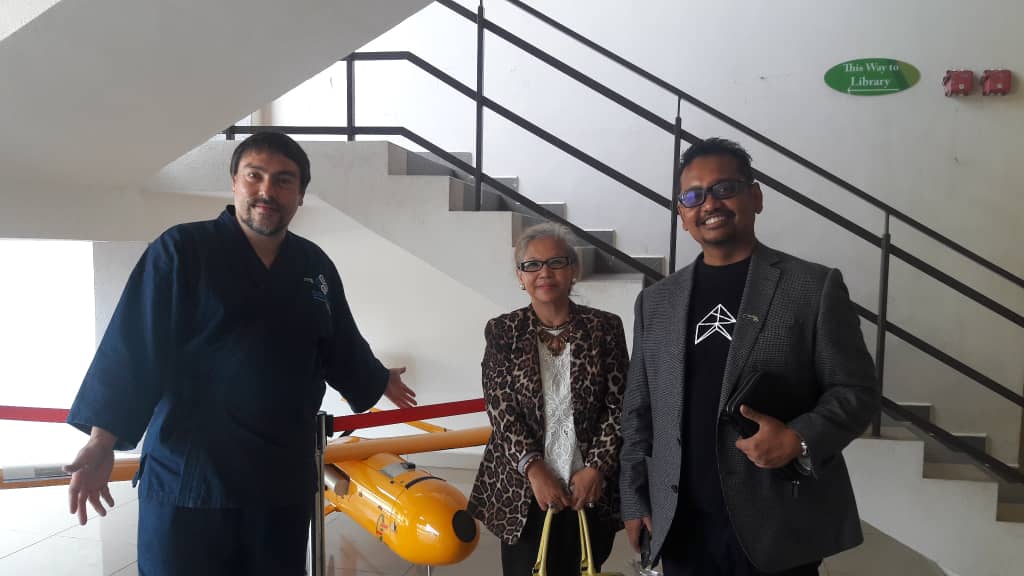
MDEC which has been appointed as Member of the WEF’s Drone Tech Committee and which has an AI Unit, could be the Malaysian partner to establish the specific Drone Tech VC fund and AI VC fund with international venture capitalists experienced in these technology investments.
Contribution by:
Sheriffah Noor Khamseah Al-Idid binti Dato’ Syed Ahmad Idid, an Innovation & Nuclear Advocate and Alumna, Imperial College, University of London, United Kingdom, had served as Special Officer to Malaysia’s Science Advisor to the Prime Minister and was Chairman of the Drafting Committee for Report on Enhancing Venture Capital Financing for Malaysia and the Strategist and Author of the Report on Introducing Business Angel Financing for Malaysia. These two high-tech Financing Reports were submitted to Malaysia’s Ministry of Finance (MoF) in 1999 and 2001 and several recommendations outlined in these reports were incorporated into Malaysia’s 10-Year Financial Sector Master Plan published by Bank Negara Malaysia.
Specific venture capital funds have been established, including MSC Venture Fund for ICT and Biotech VC fund for biotechnology. Thus, it is imperative for the Malaysian Government in partnership with national and international investors to set up specific venture funds to support 4IR technologies such as Drone Tech VC Fund and Artificial Intelligence (AI) VC Funds.
Drone Technology Investor Dr Soki Ohmae, Co-Founder & Managing Partner Drone Fund (VC Fund) from Japan and Investee Dr Kamarul Ariffin, Founder & CEO Aerodyne Group from Malaysia and Ms Sheriffah at My DroneX Workshop in Cyberjaya.

MDEC which has been appointed as Member of the WEF’s Drone Tech Committee and which has an AI Unit, could be the Malaysian partner to establish the specific Drone Tech VC fund and AI VC fund with international venture capitalists experienced in these technology investments.
Contribution by:
Sheriffah Noor Khamseah Al-Idid binti Dato’ Syed Ahmad Idid, an Innovation & Nuclear Advocate and Alumna, Imperial College, University of London, United Kingdom, had served as Special Officer to Malaysia’s Science Advisor to the Prime Minister and was Chairman of the Drafting Committee for Report on Enhancing Venture Capital Financing for Malaysia and the Strategist and Author of the Report on Introducing Business Angel Financing for Malaysia. These two high-tech Financing Reports were submitted to Malaysia’s Ministry of Finance (MoF) in 1999 and 2001 and several recommendations outlined in these reports were incorporated into Malaysia’s 10-Year Financial Sector Master Plan published by Bank Negara Malaysia.
1 Wahlster: US, Germany Must Combine Strengths to Deliver Products to World September 19, 2016 by Brett Brune - Editor in Chief, Smart Manufacturing
2 Regulation for the Fourth Industrial Revolution, UK Government, 11 June 2019 The Fourth Industrial
3 The Fourth Industrial Revolution: Shaping A New Era, Thomas Philbeck and Nicholas Davis, Columbia, SIPA, Journal of International Affairs; Jan 22, 2019
4 How will the Fourth Industrial Revolution Transform How We Govern? Arvind Satyam December 18, 2018, CISCO Blogs
5 The 4Ir is here. Do we need to design development initiatives differently? Arnaldo Pellini and Vanesa Weyrauch, Politics & Ideas
6 How to Respond to the Fourth Industrial Revolution, or the Second Information Technology Revolution? Dynamic New Combinations between Technology, Market, and Society through Open Innovation (Lee, Yun, et. al.) Received: 3 April 2018; Accepted: 4 June 2018; Published: 21 June 2018
